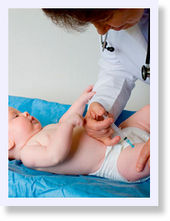Jane Elliot
BBC NewsFri, 22 May 2009 00:25 UTC

Julian finds gardening relaxing
Julian Holland struggled to feel comfortable in social settings and had a debilitating lack of self-confidence.
For a long time he was reluctant to step outside his front door and took little care over the state of his home or appearance.
He suffered a breakdown last year and was hospitalized for three weeks.
Today however he is feeling much better and he puts that down to his involvement in a lottery funded special gardening project - Twigs (Therapeutic Gardening Work in Swindon) - that gives his life a new purpose.
Some baby foods contain as much sugar and saturated fats as chocolate cookies or cheeseburgers.
A survey of more than 100 foods for babies and toddlers found examples that were 29 percent sugar, and others that contained trans fats, which have been linked to heart disease.
The Children's Food Campaign, part of food and farming campaign group Sustain, examined the nutritional content of 107 baby and toddler foods. Only half the products were low in saturated fat, salt and sugar.
Gregg Zoroya
USA TodayThu, 21 May 2009 17:04 UTC

© 2006 pool photoGen. Peter Chiarelli
Washington - Army commanders are failing to punish or seek treatment for a growing number of soldiers who test positive for substance abuse, possibly because they don't want to lose any more combat troops, the Army's vice chief of staff has warned.
In a May 8 memo to commanders provided to
USA Today, Gen. Peter Chiarelli said hundreds of soldiers involved in "substance abuse-related misconduct (including multiple positive urinalyses)" were not processed for possible discharge. He also noted that many are not referred to the Army Substance Abuse Program for help.
Most cancers are rare in people with Down syndrome, whose overall cancer mortality is below 10 percent of that in the general population. Since they have an extra copy of chromosome 21, it's been proposed that people with Down syndrome may be getting an extra dose of one or more cancer-protective genes. The late cancer researcher Judah Folkman, MD, founder of the Vascular Biology Program at Children's Hospital Boston, popularized the notion that they might be benefiting from a gene that blocks angiogenesis, the development of blood vessels essential for cancer's growth, since their incidence of other angiogenesis-related diseases like macular degeneration is also lower. A study from Children's confirms this idea in mice and human cells and identifies specific new therapeutic targets for treating cancer.
Publishing online May 20 in the journal Nature, cancer researcher Sandra Ryeom, PhD, and colleagues from Children's Vascular Biology Program show that a single extra copy of Dscr1 (one of the 231 genes on chromosome 21 affected by trisomy, with three copies rather than two) is sufficient to significantly suppress angiogenesis and tumor growth in mice, as well as angiogenesis in human cells. The team also found its protein, DSCR1, to be elevated in tissues from people with Down syndrome and in a mouse model of the disease.
Further study confirmed that DSCR1 acts by suppressing signaling by the angiogenesis-promoting protein vascular endothelial growth factor (VEGF). In a mouse model of Down syndrome, endothelial cells (which make up blood vessel walls) showed a decreased growth response to VEGF when they had an extra copy of Dscr1. An extra copy of another chromosome 21 gene, Dyrk1A, also appeared to decrease cells' response to VEGF.
A family-based prevention program designed to help adolescents avoid substance use and other risky behavior proved especially effective for a group of young teens with a genetic risk factor contributing toward such behavior, according to a new study by researchers at the University of Georgia.
For two-and-a-half years, investigators monitored the progress of 11-year-olds enrolled in a family-centered prevention program called Strong African American Families (SAAF), and a comparison group. A DNA analysis showed some youths carried the short allele form of 5-HTTLPR. This fairly common genetic variation, found in over 40 percent of people, is known from previous studies to be associated with impulsivity, low self-control, binge drinking, and substance use.
Physical and sexual abuse was endemic in Irish institutions for boys run by religious between 1940 and the late 1970s, said an independent commission report.
A report released May 20 by the Commission to Inquire Into Child Abuse said a climate of fear created by pervasive, excessive and arbitrary punishment permeated most of Ireland's institutions for children and all those run for boys. Children lived with the daily terror of not knowing where the next beating was coming from, said the report.
In addition to being hit and beaten, witnesses described other forms of abuse such as being flogged, kicked and otherwise physically assaulted, scalded, burned and held under water. Witnesses reported being beaten in front of other staff, residents, patients and pupils as well as in private.
Regions of the brain that process pleasurable experiences such as sweet tastes and sexual stimuli are the same ones that determine whether an individual is a "people person," say European researchers.
They used MRI to scan the brains of 41 males who'd completed a questionnaire designed to measure their emotional warmth and sociability. Those who were most social had greater concentrations of grey matter (brain-cell containing tissue) in the orbitofrontal cortex (the outer strip of the brain just above the eyes) and in the ventral striatum (located in the center of the brain).
Previous research has shown that both areas play an important role in processing simple rewards such as sweet tastes or sexual stimuli.
On August 28, with the pronouncement, "Inequalities are killing people on a grand scale," the World Health Organization's Commission on the Social Determinants of Health released its report,
Closing the Gap in a Generation: Health Equity through Action on the Social Determinants of Health.The Commission confirmed previous reports of health inequities between nations as well as "health gradients" within them. It confirmed that the poor are worse off than those less deprived, the less deprived are worse off than those with average incomes, and so on, up the social hierarchy. It confirmed that this health gradient exists in all nations, including the richest. It also confirmed that health equality cannot be achieved by medical systems alone.
Water-borne diseases are not caused by a lack of antibiotics but by dirty water, and by the political, social, and economic forces that fail to make clean water available to all; heart disease is caused not by a lack of coronary care units but by the lives people lead, which are shaped by the environments in which they live; obesity is not caused by moral failure on the part of individuals but by the excess availability of high-fat and high-sugar foods.

© UnknownInfants can get up to 20 Vaccinations in their first 6 months.
A survey of 274 studies conducted by researchers from the internationally prestigious Cochrane Vaccine Field in Italy, and published in the
British Medical Journal on October 28, 2006 stated that flu vaccines have not been shown to be effective or safe. The Journal of the American Medical Association (JAMA), the National Vaccine Information Center is calling on the Centers for Disease Control (CDC) to stop recommending annual flu immunization.
The latest crystal-ball decree (May 8, 2009) out of the World Health Organization and the Centers of Disease Control (CDC) is that 2 billion humans (one-third of Earth's population) could be infected this fall and winter with the current swine flu virus or its genetic derivatives. It is now being considered to rush and make 600 million doses of a vaccine. The federal government may be asking Americans to receive not one flu vaccine, but three. That's quite an overreaction, given two somewhat related deaths in the U.S. and a few hundred folks running a fever with some diarrhea.
Alice Park
Time.comWed, 20 May 2009 17:22 UTC
Among the many mysteries that befuddle autism researchers: why the disorder affects boys four times more often than girls. But in new findings reported online today by the journal Molecular Psychiatry, researchers say they have found a genetic clue that may help explain the disparity.
The newly discovered autism-risk gene, identified by authors as CACNA1G, is more common in boys than in girls (why that's so is still not clear), and the authors suggest it plays a role in boys' increased risk of the developmental disorder. CACNA1G, which sits on chromosome 17, amid other genes that have been previously linked to autism, is responsible for regulating the flow of calcium into and out of cells. Nerve cells in the brain rely on calcium to become activated, and research suggests that imbalances in the mineral can result in the overstimulation of neural connections and create developmental problems, such as autism and even epilepsy, which is also a common feature of autism.